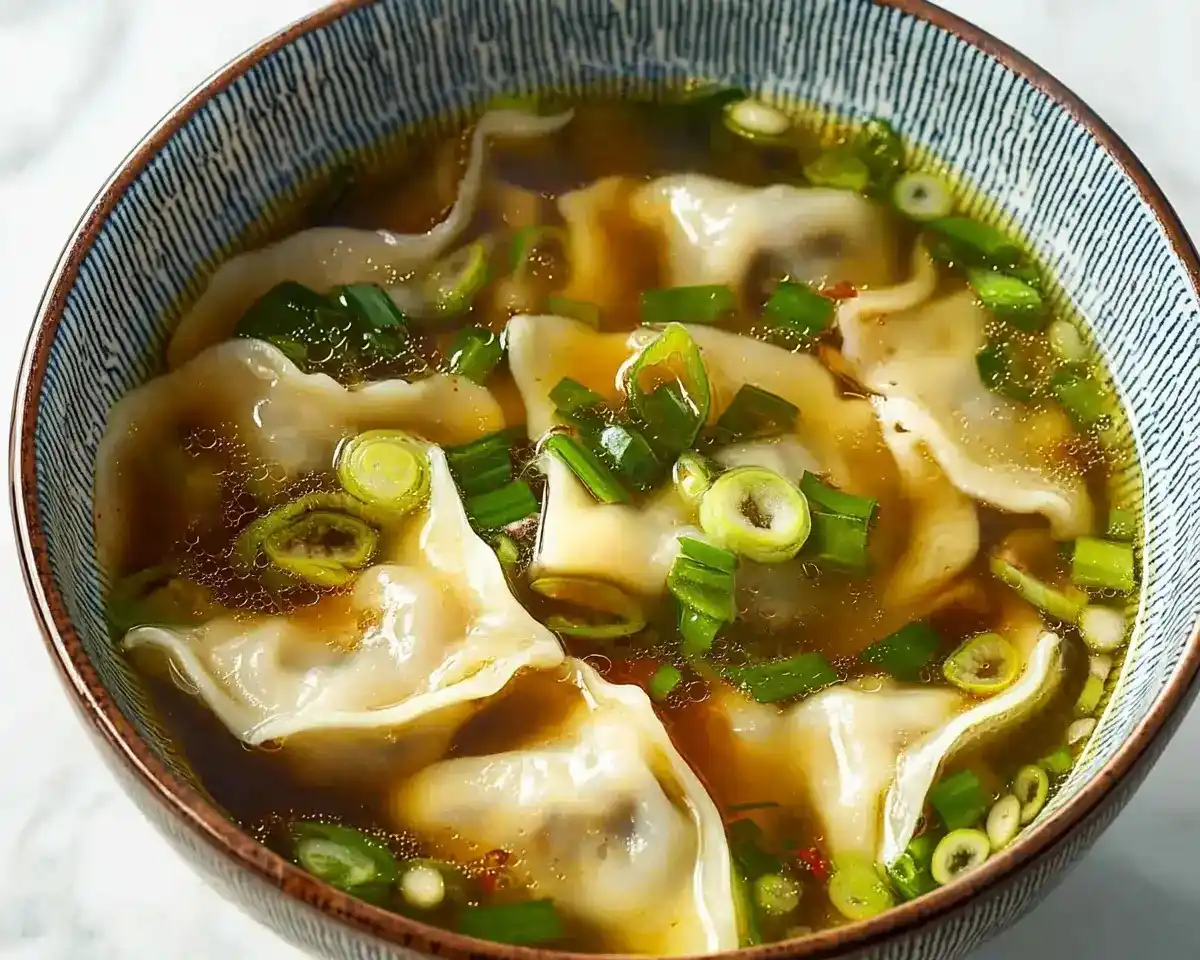Gyoza soup recipe (Japanese Dumpling Soup) with tender dumplings, fresh vegetables, and aromatic broth. Ready in 15 minutes with authentic Japanese flavors.
Hi, I’m Linda, and welcome to Tasty at Home—a cozy corner where bold flavors meet everyday kitchens. One rainy Tuesday evening in Chicago, I craved something warm and soul-soothing. That’s when I stumbled upon this incredible gyoza soup recipe. Let me tell you, the steam rising from that first bowl transported me straight to a tiny ramen shop in Tokyo’s bustling streets.
I’ve tested this recipe countless times—overcooking the gyoza and under-seasoning the broth—so you don’t have to experience those kitchen mishaps. Whether you’re a Japanese cuisine newcomer or a seasoned home cook, this comforting bowl delivers restaurant-quality flavors in just minutes.
This Japanese dumpling soup combines tender vegetable gyoza with aromatic broth. Moreover, fresh vegetables add both nutrition and vibrant colors. You’ll discover how simple ingredients transform into something extraordinary.
Table of Contents
What Makes This Gyoza Soup Special
This recipe stands apart from typical dumpling soups because it balances umami-rich broth with fresh vegetables. Furthermore, the cooking method preserves each gyoza’s texture while infusing the broth with incredible flavor. The secret lies in layering flavors—starting with chili oil aromatics and building complexity through each ingredient addition.
Traditional Japanese dumpling soup often requires hours of preparation. However, this streamlined version delivers authentic taste in under fifteen minutes. The combination of ginger, garlic, and soy sauce creates that distinctive Japanese flavor profile Americans love.
Well, here’s what sets this version apart: the spiralized courgette adds a delightful textural contrast. Additionally, the pak choi provides a subtle peppery note that complements the gyoza perfectly.
Essential Ingredients for Gyoza Soup
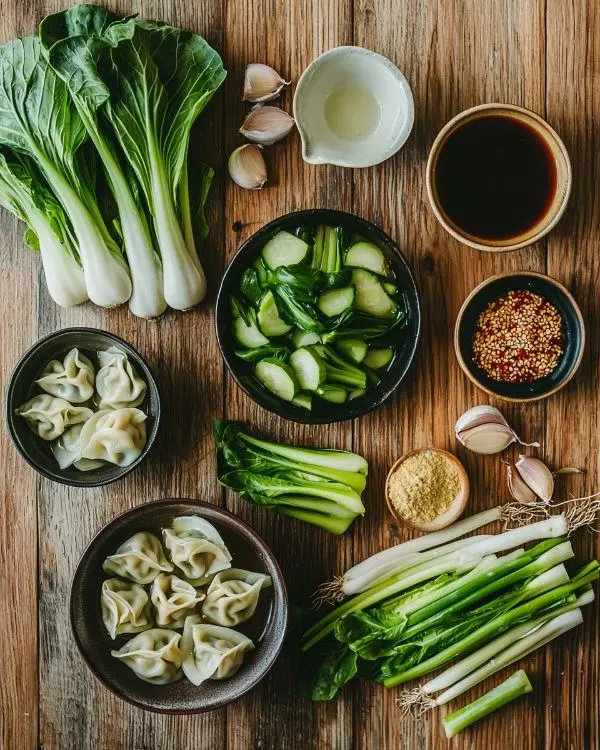
| Ingredient | Amount | US Equivalent | Purpose |
|---|---|---|---|
| Vegetable gyoza | 5 pieces | 5 pieces | Main protein/texture |
| Spring onions | 2 stalks | 2 scallions | Aromatic base & garnish |
| Pak choi | ½-1 bulb | ½-1 small bok choy | Fresh vegetable element |
| Fresh ginger | 20g | 1 tablespoon grated | Warming spice |
| Garlic | 1 clove | 1 clove minced | Umami foundation |
| Courgette | ½ medium | ½ medium zucchini | Noodle substitute |
| Vegetable stock | 500ml | 2⅛ cups | Soup base |
| Soy sauce | 1 tablespoon | 1 tablespoon | Salty umami |
| Chili oil | 1 tablespoon | 1 tablespoon | Heat & flavor |
When shopping at your local grocery store, look for frozen gyoza in the international aisle. Most American supermarkets now carry high-quality options. Fresh ginger should feel firm and have smooth, tight skin. Similarly, choose pak choi with crisp leaves and firm white stems.
You know what I learned the hard way? Not all chili oils are created equal. Look for ones with visible chili flakes and aromatic oil. This ingredient makes or breaks the soup’s final flavor profile.
Bold Add-ins and Creative Variations
Transform this basic recipe by incorporating seasonal vegetables. During autumn, add thinly sliced mushrooms for earthy depth. Winter calls for additional root vegetables like carrots or daikon radish. Spring brings fresh peas and tender asparagus spears.
For protein variations, consider adding:
- Thinly sliced chicken breast (poaches beautifully in the hot broth)
- Firm tofu cubes for vegetarian protein
- Soft-boiled eggs for richness
- Cooked shrimp added during the last minute
International readers can substitute pak choi with baby spinach or regular cabbage. Similarly, courgette can be replaced with thinly sliced cucumber or bean sprouts for different textures.
Equipment and Preparation Essentials
Required Equipment
You’ll need a medium-sized saucepan with a tight-fitting lid. Additionally, a spiralizer creates perfect courgette noodles. However, a sharp knife works just fine for thin slicing. A fine grater handles the ginger effectively.
Professional tip from Thomas Keller: mise en place transforms cooking. Prepare all ingredients before heating the pan. This prevents overcooking delicate vegetables while searching for the next ingredient.
Step-by-Step Cooking Instructions
Building the Aromatic Base
Start by heating chili oil in your medium saucepan over low heat. This gentle warming releases the oil’s fragrant compounds without burning. Next, add the white portions of sliced spring onions and season lightly with salt.
Cook these aromatics for two minutes, stirring occasionally. The onions should soften slightly but maintain their shape. This foundation creates the soup’s flavor backbone.
Man, oh man, I used to rush this step and ended up with bitter, burned garlic. Take your time here—it’s worth the patience.
Adding Garlic and Ginger
Add minced garlic and grated ginger to the fragrant oil mixture. Stir constantly for one minute, releasing their essential oils. The kitchen should smell absolutely incredible at this point.
Watch carefully during this step. Garlic burns quickly and turns bitter. If you notice any browning, reduce the heat immediately.
Incorporating Main Ingredients
Now comes the exciting part! Add all remaining ingredients simultaneously: gyoza, pak choi chunks, spiralized courgette, vegetable stock, and soy sauce. This method ensures even cooking throughout.
Stir gently to combine everything without breaking the delicate gyoza wrappers. Cover with the lid and bring to a gentle simmer.
Final Cooking Phase
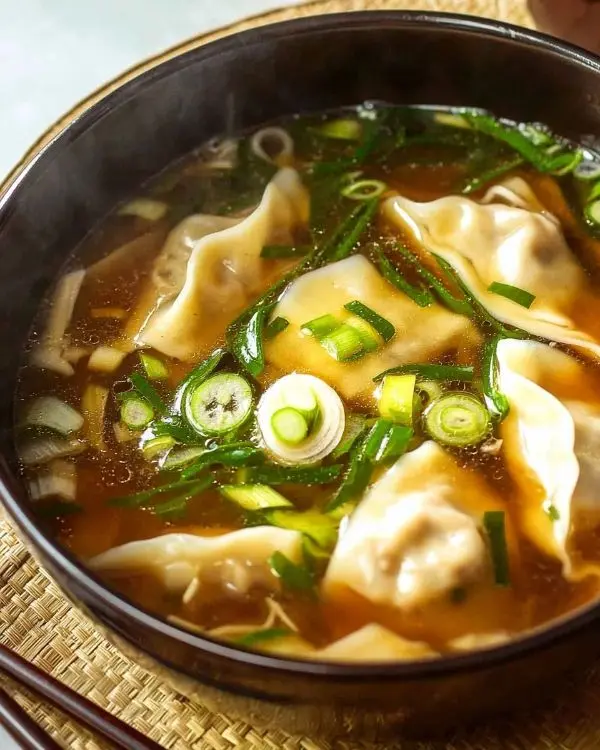
Simmer the covered soup for exactly seven minutes. This timing ensures the gyoza heat through completely while vegetables maintain their texture and vibrant colors.
During cooking, resist lifting the lid frequently. Steam helps cook the gyoza evenly while preserving the broth’s concentrated flavors.
Oops! I used to cook this for ten minutes and ended up with mushy vegetables. Seven minutes delivers the perfect balance of tender gyoza and crisp vegetables.
Expert Tips for Perfect Gyoza Soup Results
Temperature Control Secrets
Maintaining gentle heat prevents the gyoza from bursting open. Furthermore, low simmering preserves the vegetables’ nutritional value and bright colors. Professional chefs like Julia Child always emphasized gentle cooking for delicate ingredients.
If your burner runs hot, use a heat diffuser. This simple tool prevents scorching while ensuring even heat distribution.
Seasoning Balance
Taste the broth after five minutes of cooking. Add additional soy sauce if needed, but remember—you can always add more, but you can’t take it away. Salt enhances all other flavors, so season thoughtfully.
The chili oil provides both heat and complexity. Start with the recommended amount, then adjust according to your heat tolerance.
Timing Is Everything
Prepare all ingredients before starting to cook. This Japanese dumpling soup comes together quickly once you begin. Having everything ready prevents overcooking while you scramble for ingredients.
Storage and Make-Ahead Tips
| Storage Method | Duration | Best Practices |
|---|---|---|
| Refrigerator | 2-3 days | Store broth and solids separately |
| Freezer | 1 month | Freeze broth only, add fresh gyoza when reheating |
| Room temperature | Not recommended | Consume immediately for best quality |
For meal prep, prepare the broth base and store refrigerated. Add fresh gyoza and vegetables when ready to serve. This method maintains optimal texture and prevents soggy dumplings.
Creative Serving Suggestions
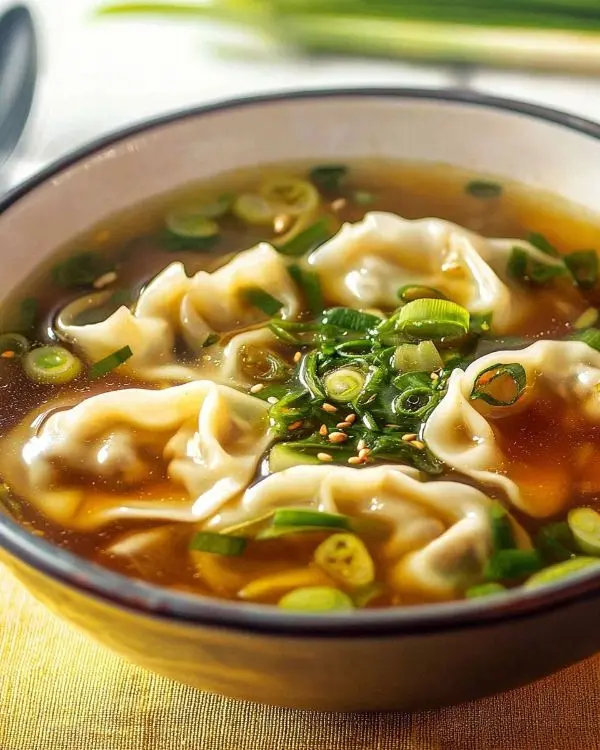
Serve this comforting soup with steamed jasmine rice for a heartier meal. Additionally, consider pairing it with our Japanese Chicken Yakitori for an authentic Japanese dinner experience.
During colder months, double the recipe for satisfying leftovers. The flavors actually improve overnight as they meld together beautifully.
For entertaining, set up a gyoza soup bar with various toppings: extra chili oil, sesame seeds, nori sheets, and fresh herbs. Guests love customizing their bowls.
Regional and Dietary Variations
American-Style Adaptations
Add corn kernels for a distinctly American twist. Frozen corn works perfectly and adds natural sweetness. Similarly, bell peppers provide color and crunch that appeals to American palates.
For Thanksgiving fusion, incorporate leftover turkey instead of traditional protein options. The rich broth complements turkey’s mild flavor beautifully.
Dietary Modifications
Gluten-Free Version: Use tamari instead of soy sauce and ensure your gyoza are gluten-free. Many brands now offer excellent gluten-free dumpling options.
Low-Sodium Adaptation: Reduce soy sauce and use low-sodium vegetable stock. Increase ginger and garlic for flavor compensation.
Keto-Friendly Option: Replace gyoza with cauliflower florets and increase the fat content with additional chili oil or sesame oil.
International Fusion Ideas
Korean-inspired version: Add kimchi and gochujang for fermented complexity. Thai variation: Include lemongrass and fish sauce for Southeast Asian flair. Each adaptation creates a unique flavor profile while maintaining the soup’s comforting essence.
Want to explore more Asian flavors? Try our Japanese Katsu Bowls for another satisfying meal option.
Troubleshooting Common Issues
Preventing Gyoza from Falling Apart
Handle gyoza gently during cooking. Frozen dumplings are more fragile than fresh ones, so avoid vigorous stirring. If some gyoza break apart, don’t worry—they still taste delicious and add texture to the broth.
Balancing Flavors
If the soup tastes bland, add more soy sauce gradually. Conversely, if it’s too salty, dilute with additional stock or water. Remember, you can always adjust seasoning at the end.
Achieving Perfect Vegetable Texture
Add harder vegetables first, then softer ones. Pak choi stems need slightly longer cooking than the leaves. Separate them and add stems thirty seconds before the leaves.
Gyoza Soup FAQs
What is in gyoza soup?
Gyoza soup contains vegetable dumplings, fresh vegetables like pak choi and courgette, aromatic ginger and garlic, all simmered in seasoned vegetable stock with soy sauce and chili oil for authentic Japanese flavor.
Is gyoza the same as soup dumplings?
No, gyoza are different from soup dumplings. Gyoza are pan-fried or boiled dumplings with filling but no internal broth, while soup dumplings contain hot broth inside the wrapper itself.
How do you make gyoza soup broth?
Create gyoza soup broth by heating chili oil with aromatics like ginger and garlic, then adding vegetable stock and soy sauce. Simmer with vegetables and dumplings for concentrated, umami-rich flavor.
How to make gyoza ramen?
Transform gyoza soup into ramen by adding cooked ramen noodles during the last two minutes of cooking. Top with soft-boiled eggs, nori sheets, and extra scallions for authentic ramen presentation.
Elevate Your Japanese Cooking Journey
This gyoza soup recipe represents comfort food at its finest. The combination of tender dumplings, fresh vegetables, and aromatic broth creates a satisfying meal that warms both body and soul.
Moreover, this dish connects us to Japanese culinary traditions while remaining accessible to American home cooks. Each spoonful delivers complex flavors that seem impossible to achieve in just fifteen minutes.
As you master this recipe, consider exploring our Spicy Tuna Onigiri for another authentic Japanese experience. These rice balls make perfect appetizers before your gyoza soup course.
Serve this soup on a chilly evening with loved ones gathered around the table. The steam rising from each bowl creates an intimate atmosphere perfect for meaningful conversations. After all, the best meals bring people together.
Have you tried making gyoza soup at home? Share your creative variations and tag us on social media—we love seeing your culinary adventures. Until next time, keep exploring bold flavors in your everyday kitchen.
Tasty at Home – Where bold flavors meet everyday kitchens.
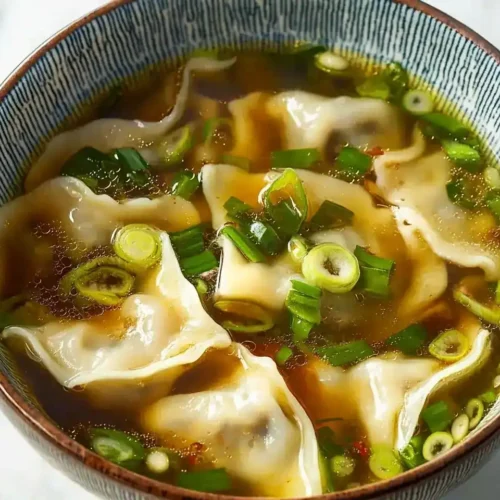
Gyoza Soup: Ultimate Japanese Dumpling Comfort Bowl
Equipment
- Medium-sized saucepan with lid
- Spiralizer (optional)
- Sharp knife
- Fine grater
Ingredients
Main Ingredients
- 5 pieces Vegetable gyoza
- 2 stalks Spring onions white portions for cooking, green for garnish
- ½-1 bulb Pak choi chopped into chunks
- 20 g Fresh ginger grated
- 1 clove Garlic minced
- ½ medium Courgette spiralized or thinly sliced
- 500 ml Vegetable stock
- 1 tablespoon Soy sauce
- 1 tablespoon Chili oil
Instructions
- Heat chili oil in a medium saucepan over low heat. Add white portions of spring onions and salt, cook for 2 minutes until softened.
- Add minced garlic and grated ginger, stir constantly for 1 minute until fragrant. Watch carefully to prevent burning.
- Add gyoza, pak choi chunks, spiralized courgette, vegetable stock, and soy sauce. Stir gently to combine and cover with lid. Bring to a gentle simmer.
- Simmer covered for exactly 7 minutes until gyoza are heated through and vegetables remain crisp. Serve immediately with optional garnishes.

